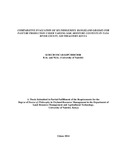Comparative evaluation of six indigenous rangeland grasses for Pasture production under varying soil moisture contents in Tana River county, South Eastern Kenya
Abstract
In response to the increasing livestock feed shortages in Kenya’s arid and semi-arid rangelands,
production and storage of hay and/or other forages for utilization during the dry seasons has been
identified as a possible strategy. However, because of the low and highly variable rainfall received in
these areas, implementation of this programme would require support of an elaborate irrigation
system. In addition, indigenous grass species which are capable of surviving in these rather hash
conditions better than most of the introduced species such as Rhodes grass and alfalfa must be
incorporated. The initiative should address such questions as which grass species should be
cultivated in which areas, and what crop husbandry practices, especially watering will give the best
results. The aim of this study was to evaluate the productivity of six range grasses under varying soil
moisture contents (80, 50 and 30% Field Capacity; and rainfed conditions), in pure and mixed stands.
The study evaluated water use efficiency (WUE) plus the quantity and quality of seeds of each
species and how they were affected by the method of storage and length of storage. Finally, the study
evaluated the effects of stage of maturity, curing methods and storage on its quality. The grasses
evaluated were Chloris roxburghiana- (CR), Eragrostis superba -(ES), Enteropogon macrostachyus-
(EM), Cenchrus ciliaris- (CC), Chloris gayana -(CG), and Sorghum sudanense -(SB).
As expected, watering treatments had a positive and significant (p≤0.05) effect on above
ground dry matter (AGDM) yields in all the grasses in pure and mixed stands. SB had the highest
yields (13.7t ha-1) at 80% FC although not significantly different from the 50 and 30 % FC (11.6t ha1
and 7.7t ha-1, respectively.. Pure grass stands performed better than mixed stands in terms of biomass
yields. However, the highest (5-species) mixtures had higher yields than mixtures with fewer species
(2, 3 and 4 species) which was attributed to functional diversity effects. Watering also boosted tiller
heights and densities in all the species. SB was the tallest followed by CG and EM. In addition, SB
and CG performed better under lower watering profiles making them more likely species for pasture
production under irrigation under arid and semi-arid conditions.
Augmenting soil moisture, increased seed yields on all the grasses with SB having the highest
yields at 80% FC (1250 kg ha-1), compared to 700.5, 533.9 and 150.7 kg ha-1, at 50 and 30% FC, and
control, respectively. CG yielded more seeds at 30% FC (1066.8 kg ha-1) than at 80 and 50% FC and
rain fed (766.9, 866.8 and 123.7 kg ha-1, respectively). CR, on the other hand had higher seed yields
at 50 and 30 % FC (516.1 and 633.4 kg ha-1, respectively), than at 80% FC and rain fed treatment
(103 and 54.3 kg ha-1) respectively. ES and CC exhibited no difference in seed yields across the three
soil moisture levels. .
Although there were clear differences between the species, duration of seed storage between
harvesting and planting had high impact on subsequent germination rates and indices (GI). Two
weeks storage had the poorest germination rates for the six species, while more than 24 weeks storage
had the highest germination rates. For instance, SB had the highest germination rate (> 50%) when
stored for 2 weeks and >75% when stored for 36 weeks. EM seeds stored for 2 weeks achieved <10%
germination rate even after on the 14th day after sowing. With at least 12 weeks storage, all the grass
species started germinating 3 days after sowing.
In terms of forage quality, all the species exhibited a significant (p≤0.05) decline in crude
protein (CP) content as the plants aged. SB hand the lowest CP content of the six species. Curing
period did not substantially affect the CP content, while indoor storage had significantly (p≤0.05)
higher CP than outdoor storage. Crude fibre (CF), neutral detergent fibre (NDF) and acid detergent
fibre (ADF) forage components increased with increase in maturity in all the species, and in the two
storage methods. On the other hand, storage method had no effect on the in sacco dry matter
digestibility (ISDMD).
As expected, the hay quality was affected by the age of the grass at harvesting and storage
methods. Indoor storage is always more beneficial than outdoor method, since it shields the forage
from the vagaries of weather. The result of this study demonstrated that harvesting the forage
between 8 and 10 weeks old, curing the material for 1-3 days before baling and storing it indoors had
better quality hay than the other handling methods.
The six grasses demonstrated distinct differences in water use efficiencies (WUE). Generally,
there was a decline in WUE with maturity in all the species. SB had the highest WUE (> 20) WUE
between the 8th and 12th week of maturity at 30% FC soil moisture content.
Citation
Doctor of Philosophy in Dryland Resource Management, University of Nairobi, 2014Publisher
University of Nairobi

